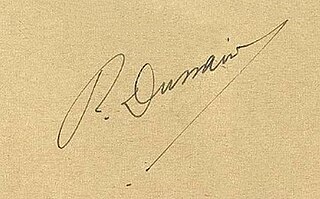Related Research Articles

The American University of Beirut is a private, non-sectarian, and independent university chartered in New York with its campus in Beirut, Lebanon. AUB is governed by a private, autonomous board of trustees and offers programs leading to bachelor's, master's, MD, and PhD degrees.

Sumur was a Phoenician city in what is now Syria. It was a major trade center. The city has also been referred to in English publications as Simyra, Ṣimirra, Ṣumra, Sumura, Ṣimura, Zemar, and Zimyra.

Kamid el-Loz, also spelled Kamid al-Lawz, is located in West Bekaa, Lebanon. The settlement has a population numbering several thousand, mostly Sunni, people and is also a site of archaeological excavations.
Tell Arbid is an ancient Near East archaeological site in the Khabur River Basin region of Al-Hasakah Governorate, Syria, about 50 kilometers north northeast of modern Al-Hasakah. It is located 45 kilometers south of Tell Mozan, the site of ancient Urkesh and about 15 kilometers from the site of Chagar Bazar. The Halafian site of Tell Arbid Abyad is a short distance away.

René Dussaud was a French Orientalist, archaeologist, and epigrapher. Among his major works are studies on the religion of the Hittites, the Hurrians, the Phoenicians and the Syriacs. He became curator of the Department of Near Eastern Antiquities at the Louvre Museum and a member of the Académie des Inscriptions et Belles-Lettres. One notable student was pioneering Jewish archaeologist Judith Marquet-Krause.
Tell el-Burak is an archaeological site located in a lush agricultural section of southern littoral of Lebanon, it has been under investigation by the American University of Beirut and the University of Tübingen since 1998. The excavations have revealed three occupations on the tell, the latest in the Ottoman Period, the next in the Iron Age, and the earliest in the Middle Bronze Age.

The Archaeology Museum of the American University of Beirut in Beirut, Lebanon is the third oldest museum in the Near East after Cairo and Constantinople.
Maya Abdallah Haïdar-Boustani is a Lebanese archaeologist and curator of the Museum of Lebanese Prehistory at Saint Joseph University, Beirut.
Tell Kazel is an oval-shaped tell that measures 350 m × 325 m at its base, narrowing to 200 m × 200 m at its top. It is located in the Safita district of the Tartus Governorate in Syria in the north of the Akkar plain on the north of the al-Abrash River approximately 18 km (11 mi) south of Tartus.
Tell El Ghassil is an archaeological site located 11 kilometres (6.8 mi) north northeast of Rayak in the Beqaa Mohafazat (Governorate) of Lebanon.
The Ancient Tell is a Tell in downtown Beirut, Lebanon. In the 1990s, the effort to rebuild Beirut following the Lebanese Civil War provided archaeologists with the unique opportunity to investigate the Tell, revealing many layers of the city.

The Phoenico-Persian Gate of ancient Tell is a monument located in downtown Beirut, Lebanon.
The Canaanite Gate of ancient Tell is a monument located in downtown Beirut, Lebanon.
The Canaanite Tombs of ancient Tell are a historical monument located in downtown Beirut, Lebanon.
Ernest Louis Georges Will was a 20th-century French archaeologist and University professor, a member of the Académie des Inscriptions et Belles-Lettres.
Arda Arsenian Ekmekji is a Lebanese Armenian scholar. She has been the dean of arts and sciences at Haigazian University since 1998, specialising in research on electoral reform, Prehistoric Armenia and the Kingdom of Urartu.

The Temple of Baalat Gebal was an important Bronze Age temple structure in the World Heritage Site of Byblos. The temple was dedicated to Ba'alat Gebal, the goddess of the city of Byblos, known later to the Greeks as Atargatis. Built in 2800 BCE, it was the largest and most important sanctuary in ancient Byblos, and is considered to be "one of the first monumental structures of the Syro-Palestinian region". Two centuries after the construction of the Temple of Baalat Gebal, the Temple of the Obelisks was built approximately 100m to the east.
Tell Amarna is an archaeological site near the village Amarnah in northern Syria, on the west bank of the Euphrates.

The Saadé family is Antiochian Greek Orthodox Christian and originates from the Syrian coastal city of Latakia. It owns two vineyards, Château Marsyas in Lebanon and Domaine de Bargylus in Syria which kept their production ongoing despite the chronic instability facing the Middle East.

The Phoenician sanctuary of Kharayeb is a historic temple in the hinterland of Tyre, Southern Lebanon, that was excavated in three stages. In 1946, Maurice Chehab, head of Lebanon's Directorate General of Antiquities, led the first mission that revealed a Hellenistic period temple and thousands of clay figurines dating from the sixth-to-first centuries BC. Excavations in 1969 by Lebanese archaeologist Brahim Kaoukabani and in 2009 by the Government of Italy yielded evidence of cultic practices, and produced a detailed reconstruction of the sanctuary's architecture.
References
- ↑ Nicola Schreiber (2003). The Cypro-Phoenician pottery of the Iron Age. BRILL. pp. 204–. ISBN 978-90-04-12854-5 . Retrieved 2 May 2011.
- ↑ SCIEM 2000 (2008). The Bronze Age in the Lebanon: studies on the archaeology and chronology of Lebanon, Syria, and Egypt, p. 10. Verlag der Österreichischen Akademie der Wissenschaften. ISBN 9783700161363 . Retrieved 2 May 2011.
{{cite book}}: CS1 maint: numeric names: authors list (link) - ↑ Zils (December 2002). Museums of the world. K.G. Saur. ISBN 978-3-598-20610-8 . Retrieved 2 May 2011.
- ↑ American Schools of Oriental Research (1997). Newsletter. The Schools. Retrieved 2 May 2011.
- ↑ Leila Badre (1990). Tell Kazel, Syria: excavations of the AUB Museum, 1985-1987 : preliminary reports. Faculty of Arts and Science, American University of Beirut. Retrieved 2 May 2011.
- ↑ Jean-François Breton; Leila Badre; Rémy Audouin (1980). Wādī Ḥaḍramawt: prospections. Centre Culturel et de Recherches Archéologiques. Retrieved 2 May 2011.
- ↑ Leila Badre (1980). Les figurines anthropomorphes en terre cuite à l'âge du Bronze en Syrie. P. Geuthner. ISBN 9782705302719 . Retrieved 2 May 2011.